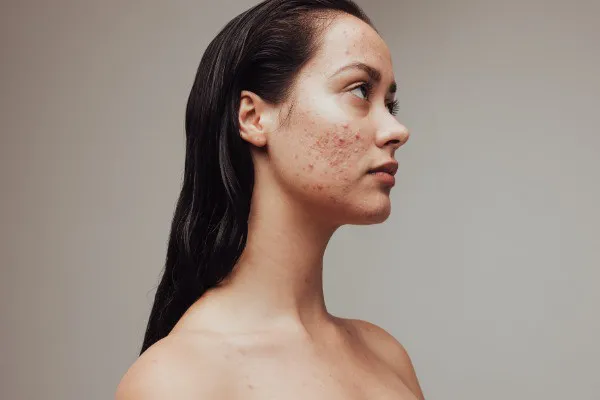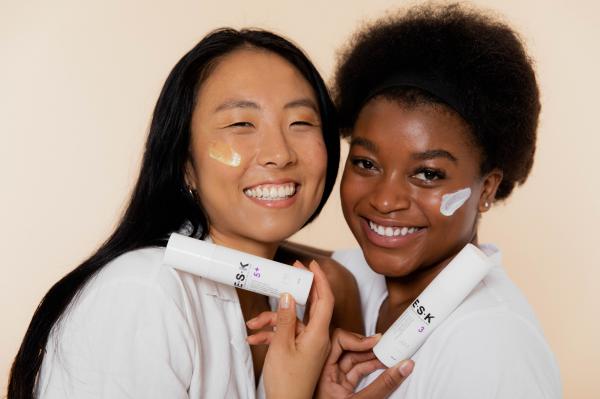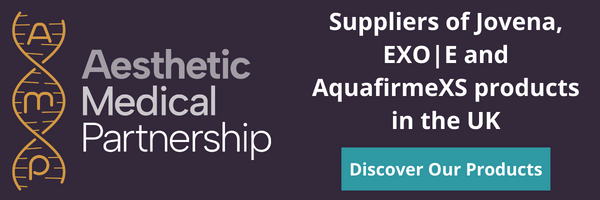
Hormonal Acne
Dr Ginni Mansberg explains the causes and treatment options
Acne vulgaris is a chronic inflammatory disorder affecting the pilosebaceous unit, which is comprised1 of the hair follicle and its associated sebaceous or oil gland and arrector pili muscle with an aperture at the skin’s surface.
In this article, I will cover the impact of hormones on acne. I will cover everything from the reason that up to 85% of women get an acne flair before their period,2 through to hormonal conditions like polycystic ovaries and even perimenopausal breakout. And through it all – the role hormones play in this skin condition.
But first, a quick overview of the four critical drivers of acne. All acne have these things in common:
- Overproduction of skin cells plus slowed skin cell turnover leads to a build-up of skin cells3 that obstruct the pilosebaceous unit.
- Excessive oil production. This is often impacted by various cyclical and life phase hormone changes.
- An overgrowth of the Cutibacterium acnes (C. acnes) bacteria.4 This is part of the healthy microbiome of the skin, but when it becomes the predominant microbe, acne results.
- Inflammation: Inflammation is at the heart of acne6 , increasing erythema, sensitivity and dryness. The C. acnes bacteria as well as any other trauma from scratching and picking, using the wrong skincare such as facial scrubs, or from sunburn, can also increase inflammation.
Which hormones can affect the skin?
- Testosterone: The main culprit here is testosterone which stimulates the oil glands to grow and pump out sebum AKA oil.7 Both men and women have and produce testosterone. Testosterone not only increases the production of oil but is also pro-inflammatory in the skin8 and increases retention of keratinocytes8 so it increases plugging of the pilosebaceous units.
- Dihydroepiandrosterone sulphate (DHEA-S): DHEA-S is the main precursor hormone made by the adrenal glands that can be converted to either testosterone or oestrogen.9 Studies have shown that the higher the levels of DHEA-S in the blood, the worse the acne.10
- Oestrogen: Oestrogen inhibits the growth of oil glands and slows down the production of oil.7 It does this partly by competing with testosterone, inhibiting its acne-charging effects.11Oestrogens are also anti-inflammatory12 and promote wound healing.13

How do hormones affect women with acne?
Menstrual acne flares
Just before the menstrual period, oestrogen and progesterone levels decline rapidly, removing the healing properties of oestrogen. Up to 85% of acne sufferers say it gets worse just before the period.14
Polycystic ovarian syndrome (PCOS)
This is the most common hormonal condition affecting women and girls.15 And acne is the commonest symptom of PCOS.16 Given how common acne is in PCOS, and conversely how common PCOS is in women with acne, we should screen for this condition17 in all women with adult-onset acne.
Perimenopause
Acne is common in menopause transition, AKA perimenopause, with studies showing that 26.3% of women are affected by acne breakouts between the ages of 40 and 49.18 PCOS might be the missing link17 in some women.
Women with peri and menopausal acne tend to have a lot of skin sensitivity, along with more redness, issues with pigmentation and scarring.18
Management of hormonal acne
Hormonal anti-acne Ingredients
1. Soap-free, gentle cleanser
Soap dries, irritates and disrupts the chemistry of the skin.19 A gentle cleanser twice a day for mild to moderate acne has been shown to reduce pimples20 without damaging the skin barrier or resulting in an overproduction of oil.
2. Vitamin A
Vitamin A skincare products are the first line for treating acne. The American Academy of Dermatology guidelines21 for acne state that “retinoids are the core of topical therapy for acne.” Retinoids work against acne in four ways21 by combatting:
a) The build-up of excess skin that plugs the pilosebaceous glands
b) Excess oil production
c) Overgrowth of C. acnes
d) Immune system overactivity and inflammation.
Dermatologists commonly prescribe prescription-only retinoids, but studies show21 that 61% of people using prescription retinoids for acne experience irritation.
Many dermatologists are now opting for an over-the-counter retinoid product like retinaldehyde, AKA retinal, the most effective and best-tolerated form22 of vitamin A. It is also more effective and less irritating than its OTC cousin, retinol.
3. Niacinamide
Niacinamide has been shown to improve skin barrier function,23 reduce inflammation24 and excess oil production.25
4. Ceramides
As mentioned previously, people with acne, including hormonal acne, have dry skin with an impaired skin barrier. Treatments like prescription vitamin A or benzoyl peroxide dry out the skin further. Studies have linked using ceramides in skincare to better outcomes in acne as they reduce TEWL, erythema and scaling.26
5. Salicylic acid
Salicylic acid a good option for acne27 as it is exfoliating and has anti-inflammatory and anti-microbial properties.28 It can be used as part of a cleanser, as a leave on balm or in dissolving microneedles to reduce pimple size and inflammation.
6. Hydroxy acids
Hydroxy acids are gentle exfoliators, helping to break down acne lesions29 while also helping improve the absorption of retinoids like retinal.30 But high concentrations can cause significant side effects.31 They can’t be used by people with sensitive skin. PHAS like gluconolactone or lactobionic acid provide similar effects as AHAs but do not cause the irritation of classical AHAs.32 PHAs are less well studied than AHAs, but those done on acne33 have shown success when used alone or in combination with other AHAs or vitamin A.34
The pH of skincare products
The acidity of the skin is essential to ensure an effective skin barrier. People with acne tend to have a more alkaline skin,35 making their acne worse. One study found there was a significant decrease in acne lesions after just four weeks of using an acidic cleanser and moisturiser.36
Procedures for hormonal acne
Laser and light therapy, as well as photodynamic therapy, have been used in studies for acne and acne scars with varying success. Other procedures, including chemical peels, injecting platelet-rich plasma, fractional radiofrequency and in-clinic microneedling, all have evidence, especially for acne scars. In terms of which is best, studies have concluded that each method has advantages and disadvantages, and the best results may come from combining different techniques (including effective skincare.)37
Dissolving microneedle patches
Relatively new in skincare, dissolving hyaluronic acid microneedle patches have been found to be both anti-bacterial and anti-inflammatory in acne.38 These microneedle patches gently penetrate the skin, delivering antiacne ingredients to the pimple, along with the hyaluronic acid itself, which has its own anti-inflammatory and wound healing properties.39
Self-care for hormonal acne
Given that stress40 and lack of sleep41 can make acne worse, getting these under control will help.
Medications for hormonal acne
Metformin
Multiple studies have found that metformin, a medication traditionally used for diabetes, has incredible benefits for all the symptoms of PCOS, including acne42, when combined with diet and exercise.
The combined oral contraceptive pill
The pill or combined oral contraceptive pill contains oestrogen, which decreases ovarian testosterone production43, reducing oil production and acne, especially in PCOS. All pills work well to do this.44 The synthetic progesterone – or progestin can either increase or decrease the effects of androgens, depending on which one is used. The most powerful anti-androgen progestins are cyproterone acetate and drosperinone.44
Spironolactone
This diuretic has remarkable anti-androgen effects, with studies showing it helps combat acne.44 It can cause fatigue and hypotension, and it can dysregulate the cycle.
Hormonal acne is super tricky and can be devastating to your patient’s self-image, but, with patience and the right combination of treatments and skincare it can be managed.
References
- Farina GA, Cherubini K, Zancanaro MA, Gonçalves F. Deoxycholic acid in the submental fat reduction: A review of properties, adverse effects and complications. J Cosmet Dermatol 2020;19:2497-2504
- Fagien S, McChesney P, Subramanian M, Jones DH. Prevention and Management of injection-related adverse effects in facial aesthetics: Considerations for ATX-101 (Deoxycholic acid injection) treatment. Dermatol Surg 2016;42:11S:S300-S304
Di Toro G, Rauso R. Skin Necrosis following adipocytolytic solution injections. Aesthet Sur J 2016;36(2):NP74-NP76 - Souyoul S, Gioe O, Emerson A, Hooper DO. Alopecia after injection of ATX-101 for reduction of submental fat. JAAD Case Reports 2017; 3(3):250-253
- Amore R, Pinto H, Gritzalas K, Hernández C, Skwara-Guzikowska K, Amuso D, Leonardi V. Intralipotherapy, The State of the Art. Plast Reconstr Surg Glob Open 2016;4:e1085
